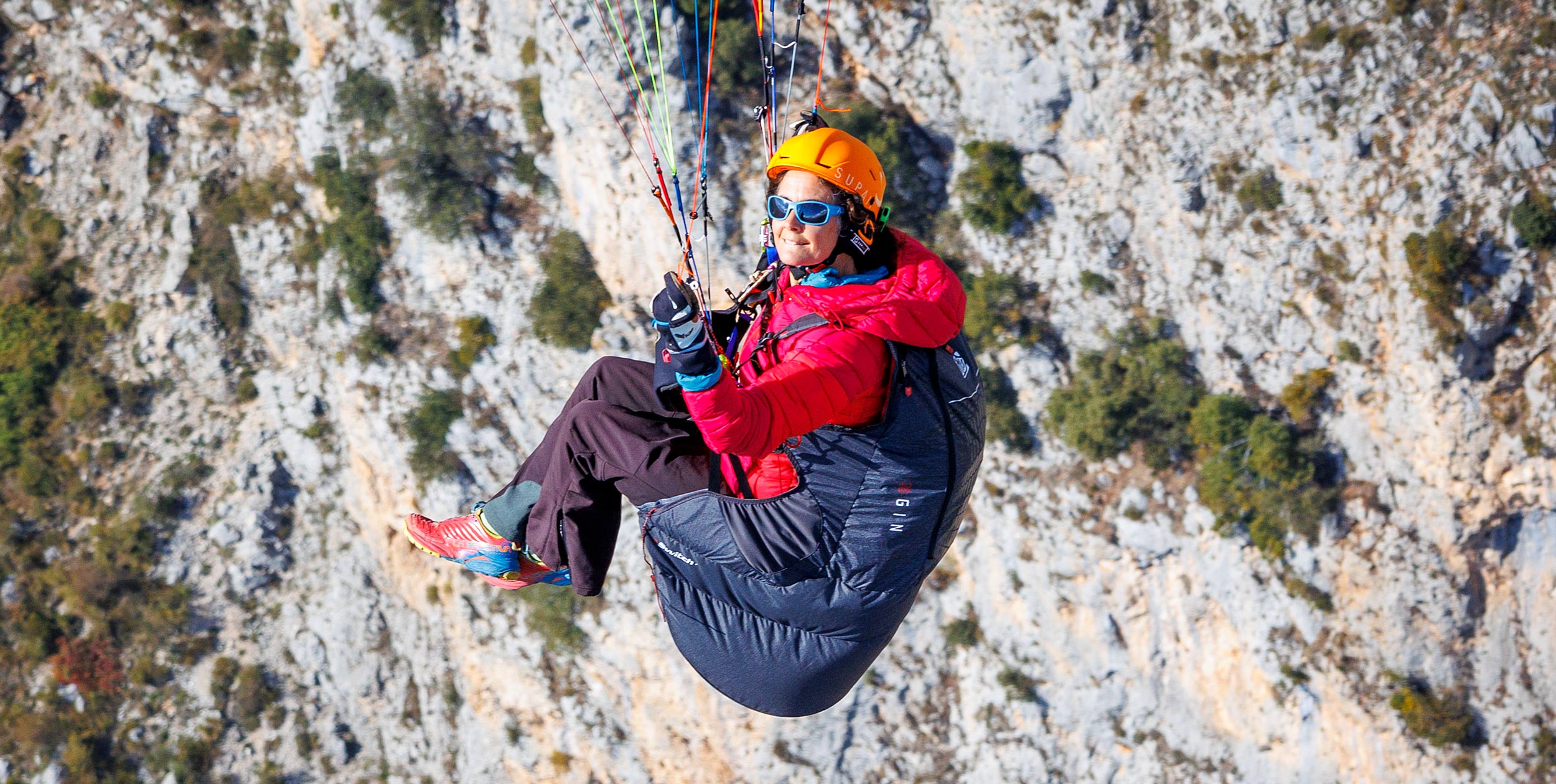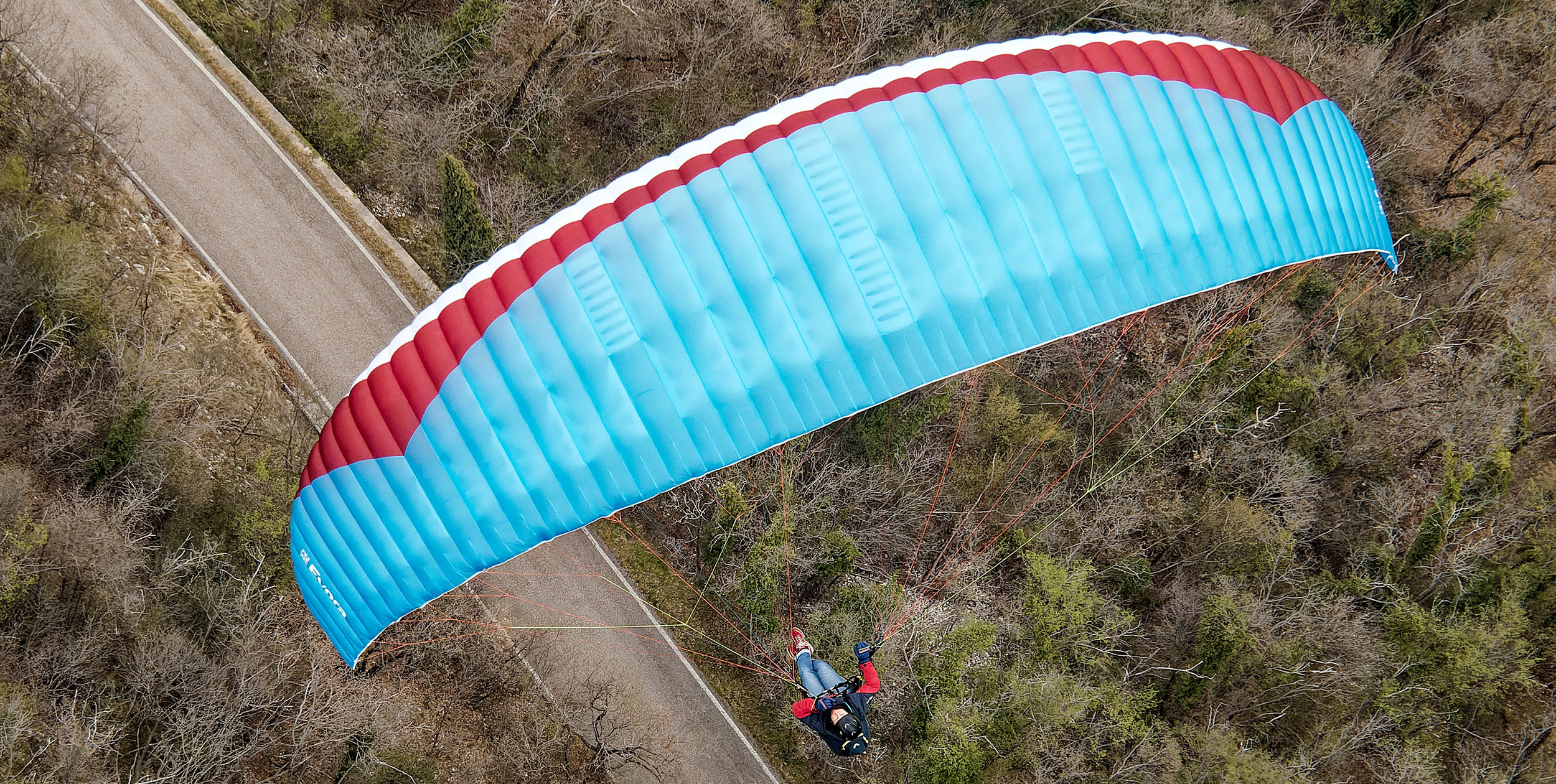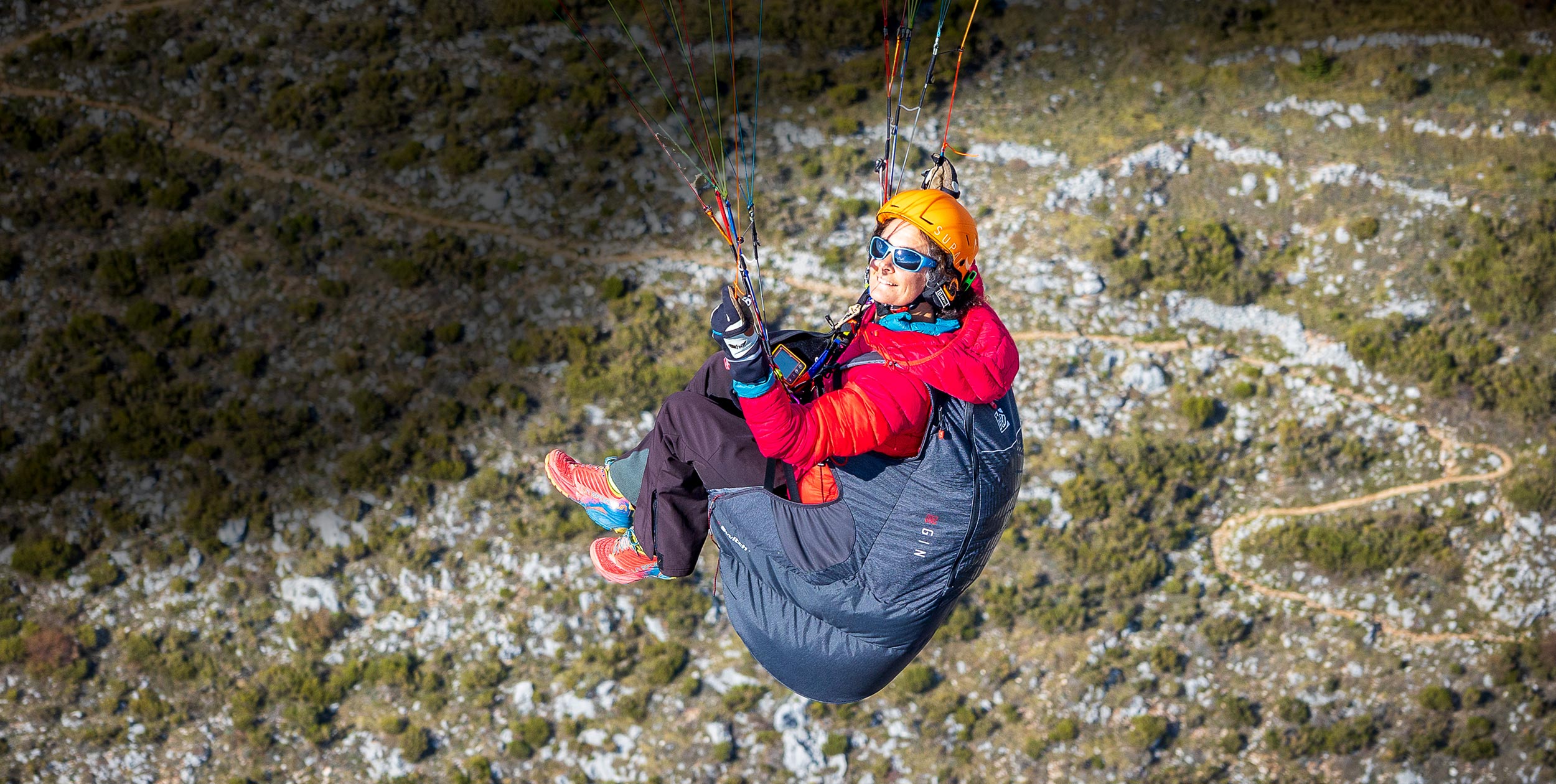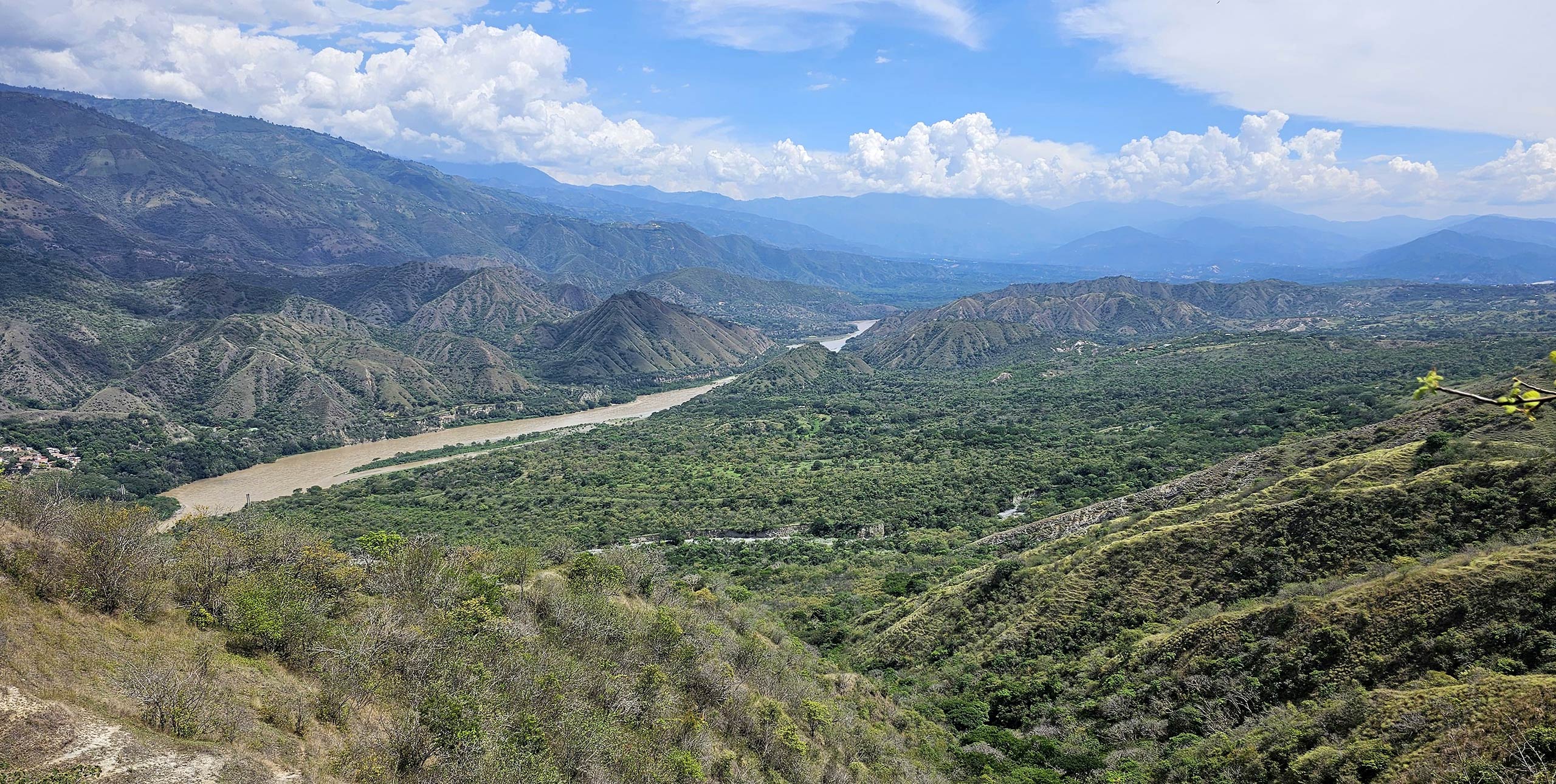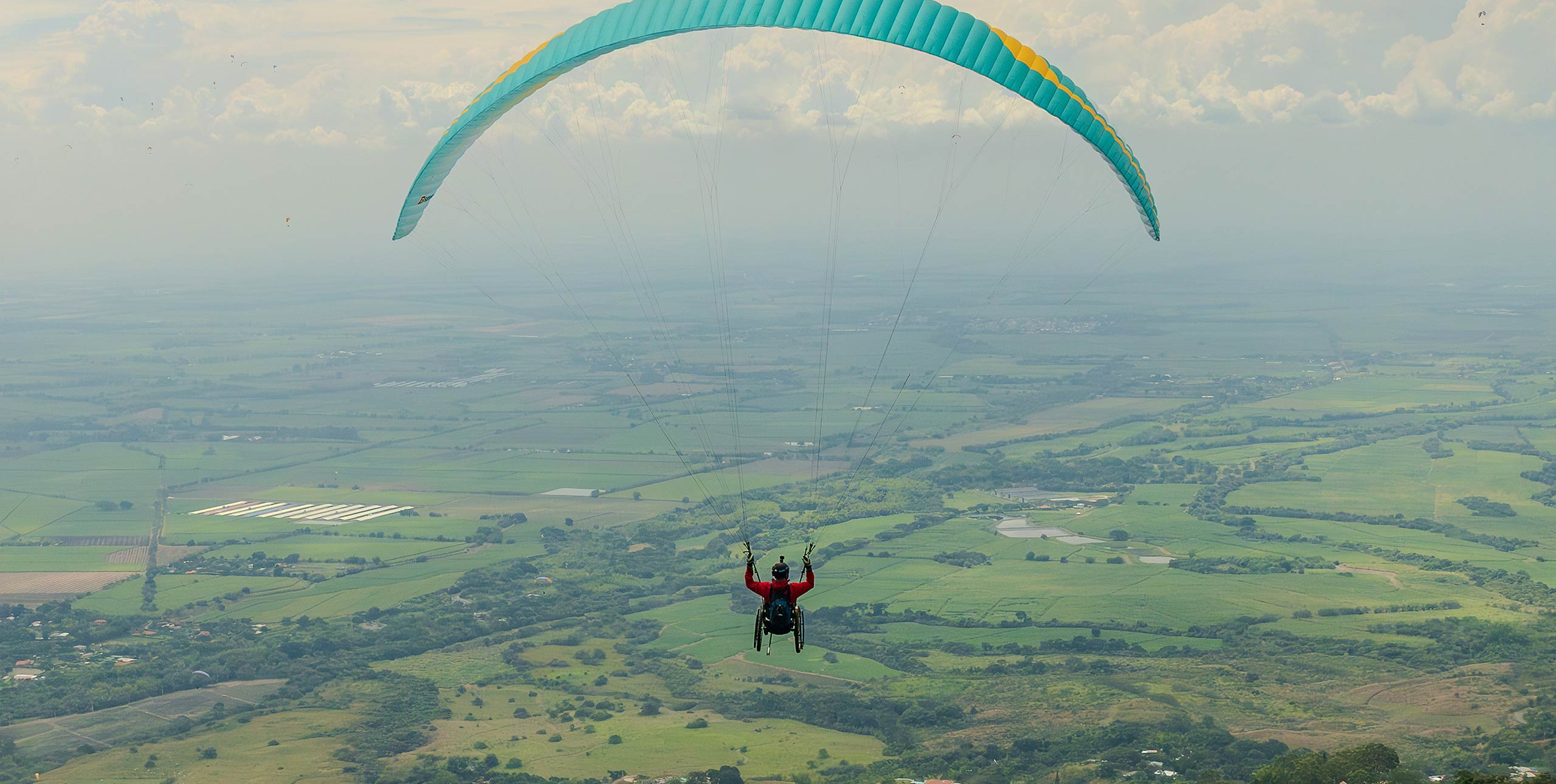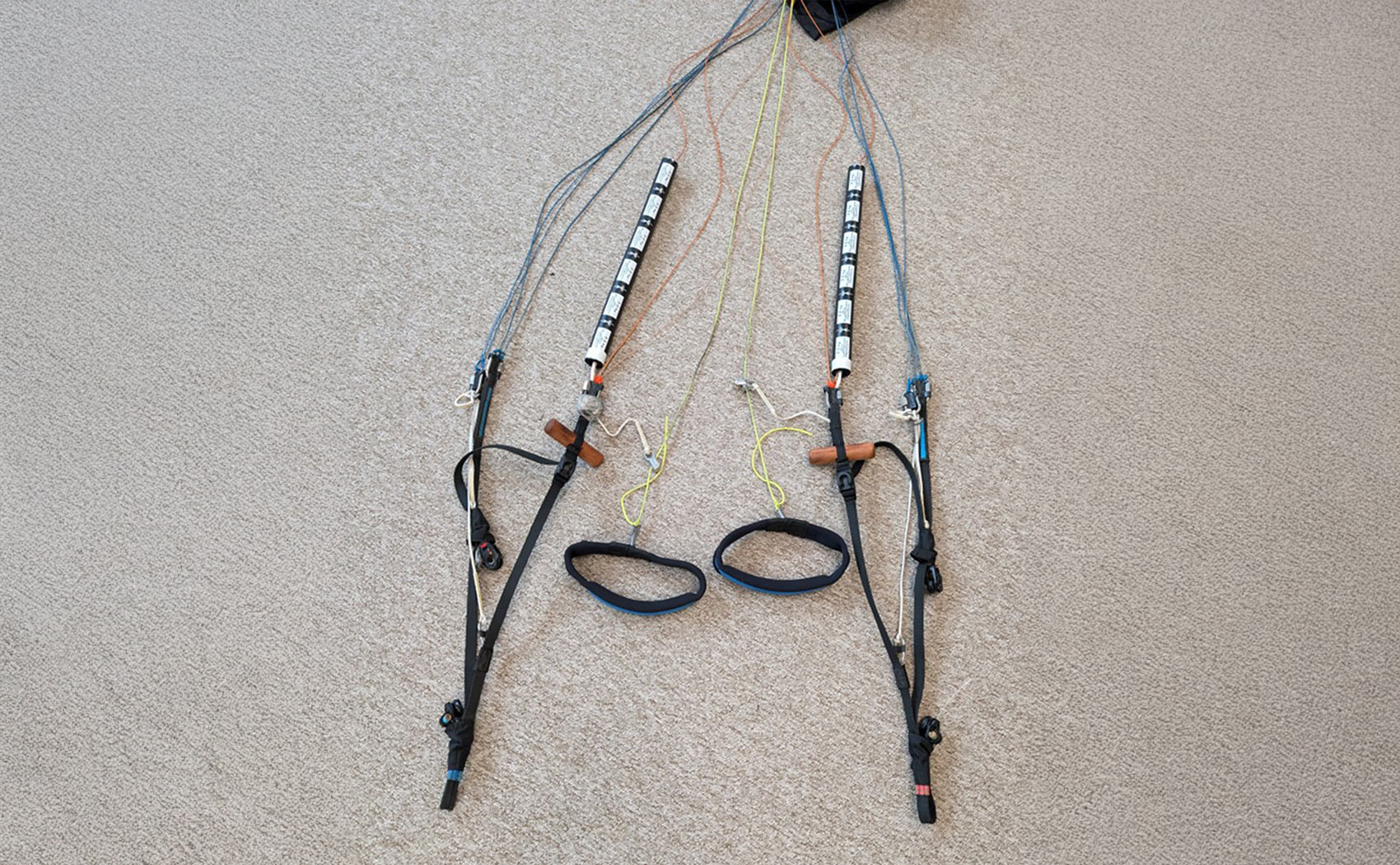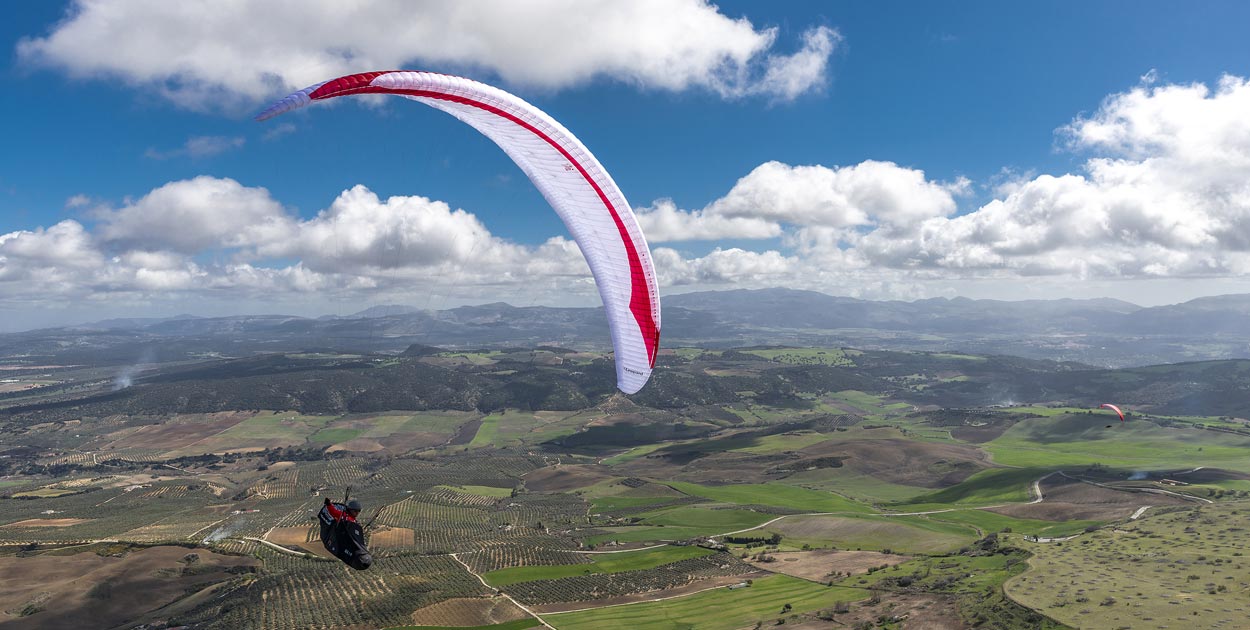
Gin’s EN D two-liner, the Leopard, is the fastest certified paraglider we’ve ever tested, reports Hugh Miller.
The Leopard is an 86-cell, highly technical two-liner with an aspect ratio of 7.15 (CIVL: 6.9) in the size we tested, S. If you’re into this class of wing you’ll be excited by those numbers already. For those less familiar, the class was pioneered by Niviuk in 2016 with the Peak 4, and developed by Ozone with their Zeno. The design is built to help pilots develop their two-line flying style on a safer, more forgiving wing than the 7.6+ A/R of CCC wings. It’s now well-established, as popular with die-hard XC pilots as it is world cup racers.
The Leopard enters the fray nearly three years on. As designer Torsten Siegel explained, “There was just no point releasing anything that wasn’t clearly better than the Zeno… and we’re very happy now!”
I’ll be honest – I’d heard stories about the Boomerang series being more sensitive to pilot than the Enzo series. When I reviewed Gin’s three-line D, the GTO 2, back in 2015, I found it slightly more demanding than its competitors. So I approached the Leopard with some caution.
Build quality
The build quality is immaculate. Sail tensioning appears impeccable, with an ultra-smooth top surface when viewed from above. Cells are grouped in 3s and 4s, and there’s some seriously complicated bracing and tensioning in play.
On the risers, if you’ve got big hands you might find the rear-riser handles a little short, but I found them OK. The brakes have the magnetic clips that fellow reviewer Lawrie Noctor disliked on the Bonanza 2 – but this is a minor quibble. The speed system has 14cm of travel, the same as the Zeno, giving exactly the same amount of speed-line travel.
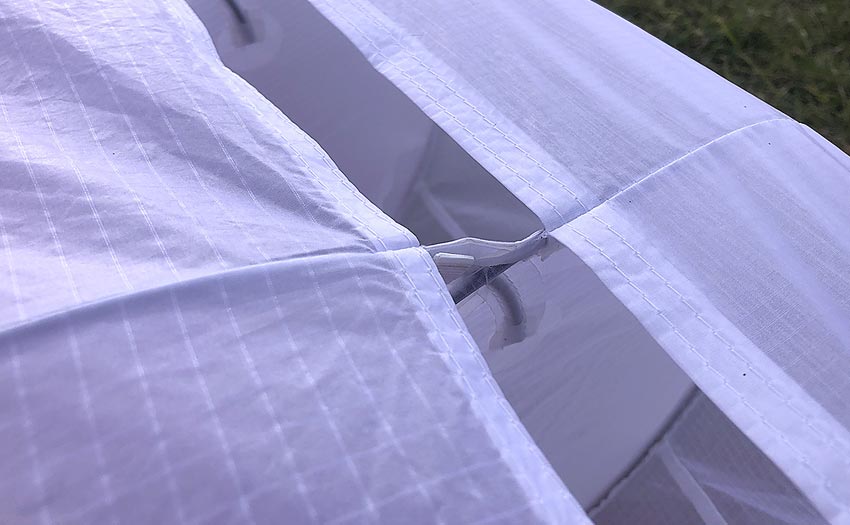
On the ground
The Leopard is similar to the UP Meru (reviewed in 2018) and Ozone Zeno (tested in 2017) in its demands – significantly easier than higher-aspect CCC wings. On my fourth day of testing, I had to launch in a tight spot, on a steep slope, and the way the Leopard leapt straight into flying position was very reassuring. There is no lag before the zenith, as is the case with some D class wings.
Leopard versus Zeno
Coming from a Zeno, immediately you’ll notice firmer brakes. It feels a little more playful, and sporty. To use a motorbike analogy, the Leopard has a more sensitive throttle. I spent a morning switching between a Zeno MS and the Leopard, the Zeno’s brakes felt spongy and like rubber bands in the first 15cm of travel, which isn’t something I expected at all, as I’ve never had any issue with the Zeno’s handling before – I’ve always enjoyed it.
Equally, the rear risers feel more taut and hard than the Zeno’s. There is less “give”, and more “bite”, in the handling.
In terms of pitch, the Leopard’s perhaps a little more steady, and neutral, when climbing. You don’t need to dab the outside brake to control pitch as much as you do with the Zeno, although in stronger 4m/s climbs, the management demand was not dissimilar.
Flapping in to land in a tight space, I found the Leopard’s stall point to be similarly progressive to the Zeno. In comparison, I noticed the Meru had a more defined spin point that needs more awareness.
Feedback in climbs
A few pilots have commented on the Leopard having “pitch back” behaviour when entering climbs, but I noticed a really helpful, and defined, surge-and-pull before this. This is a definite plus for me over the Zeno, which always felt like it blocks out some feedback, leaving me uncertain when to open up and explore. The Leopard gives you more hints, and pulls you up and forward more noticeably towards better lift.
The turn is super tight and sweet. Its agility is a revelation after flying CCC wings, and its more linear brake authority makes it really pleasurable. I had a few flutters on the wingtips in my first flight, but after 12 hours, these had gone, and it was totally solid across the span. I wonder if after a little flying, the lines and canopy settle down a little? This again is common two-liner behaviour – don’t be put off if it happens on your first couple of flights. It’s even in the manual.
Overall, the wing is cohesive, and certainly more solid than the lightweight GTO2 (which I always felt was slightly compromised by its lightweight brief), but I’d agree with Gin – it’s definitely not “stiff”.
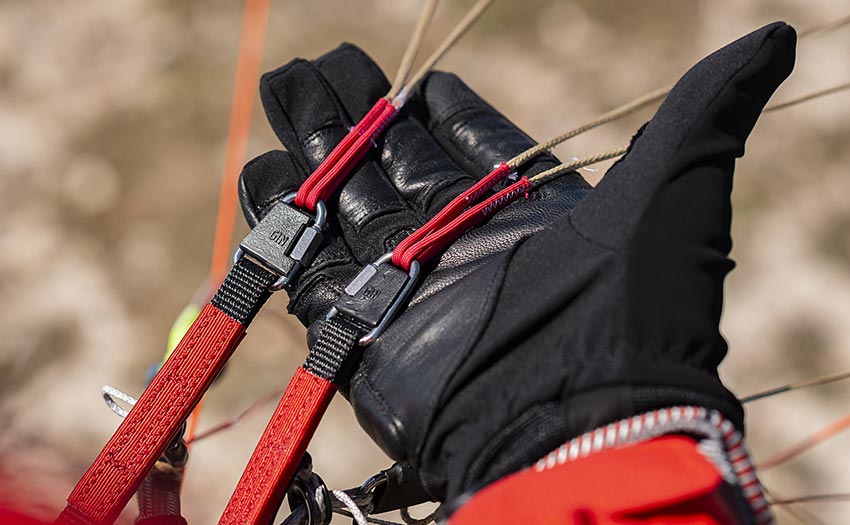
Performance
Moving from a CCC wing to a D-class two-liner, you wouldn’t think you’d gain any more top speed, would you? But that’s exactly what the Leopard offers. I didn’t believe it at first, but after four days of repeated testing with our Flymaster TAS speed probe and some long glides against an Enzo 3, I can confidently say that the Leopard is the fastest certified paraglider we’ve yet tested.
On my first day, flying at 99kg, I recorded a steady 58-59km/h with nudges of 60km/h, with pulleys just touching. This alone makes it faster than the Zeno, which we measured at 57-58km/h. After landing we measured a further 1.5cm of possible travel until pulleys are completely overlapped, and on my next two days of testing, with shortened speed lines, I managed a steady 60km/h, with occasional blips of 61-62 km/h.
Excuse my excitement, but this is a VERY fast wing! In our experience of flying with the TAS probe the very fastest three-liners we’ve tested manage 51-52km/h. The Leopard has a usable speed-bar range of 25km/h! This is nuts. Just for interest’s sake, the fastest two-liner we’ve ever recorded was the uncertified Ozone R11, at 65km/h, with trimmers released and speed bar pulleys overlapping.
On the fourth day of my testing, Mark Watts joined me for some comparative glides on his Ozone Enzo 3 M. As we all know, line trim is absolutely critical for top-speed performance, and top speeds do vary even among the same size and model. It may well be that Mark’s wing is slightly out of trim at the end of this season – but he won several competition tasks earlier in the year.
Over repeated long glides, the Leopard pulled away slowly. By releasing a little bar, giving a 1-2cm gap between pulleys, I pulled back Mark’s top speed, and at the Enzo 3’s top speed, our glide angles were comparable, with the Enzo 3 perhaps having a slight edge in choppier air. For sure, that final squeeze to get the pulleys overlapping noticeably hammers the polar. So, before we all get too excited, while I had a speed advantage, this top speed advantage would only come into play on a hard final glide with plenty of height.
But let’s face it, if you’re looking for a two-liner, performance matters. We know from competition experience that many Zenos are as fast as Enzo 3s, and that while Boomerang 11s tend to have the edge in top speed, the Enzo 3s seem to surf choppy air a tiny bit more efficiently. All these things will be borne out in time. But that all said, the Leopard still sets a new record for us at 60km/h for a certified wing.
I’m confident in this claim – our speed probe has been calibrated by Oxford University using their wind tunnel. I followed our testing protocol, flying at 3kg below the top of the weight range, accelerating to full speed and recording for 45 seconds, and the 60km/h result was repeated each time.
On glide
As mentioned, the rear risers are heavier and are a higher workload than the Zeno. Smaller movements are needed for correcting the wing in pitch as you glide fast – I get the feeling it needs a more sensitive piloting style, and might take a little more concentration.
I don’t think I got served as much information about the wing’s pitch movements as I am used to with the Zeno and Enzo 3, so I felt like I had to learn to trust the Leopard to do its own thing. Again, I can’t comment on glide performance with any authority, but it glides very comfortably at 50km/h, with around 4cm left in the tank between the pulleys. I had a few glides with Zenos, and I can’t categorically say the Leopard is better – but it seems engineered to crack on.
Conclusion
The Leopard is a born racer with the fastest speed of any certified wing we’ve ever tested. This much I can say with confidence. I can’t tell you anything about how the Leopard recovers from big collapses, and how it is to back-fly.
I also can’t say much about weight-range positioning, but between 98-101kg its climb was still outstanding. It gives acceptable but not great riser feedback on glides and remains solid – those tip collapses early on were a side show.
I’d say the Leopard’s top speed and sharper handling mean it probably does need a slightly more skilled pilot to make the most of it. This is a totally subjective statement, but switching between wings, the Zeno just felt a bit more comfortable – like it had shock absorbers. Honestly, I prefer the Leopard’s handling, and most importantly, its feedback in showing you the core.
I had one morning in really soft lift, and found it delightfully intuitive, helping me to find and hang on to the early bubbles and escape above the pack. Equally, when it gets stronger, cranking up your race harness’s roll stability locks the glider into place nicely both on glide and in rougher climbs.
My first impressions are that the Leopard would be a good choice both for flatland flyers wanting to fly fast in the middle section of the day and exploit the most of the decaying evening energy, and more skilled, fast and furious mountain racers wanting to overtake CCC wings down the ridge lines. It definitely made me smile and is on my shortlist for 2020.
GLIDER SPECIFICATIONS
Gin say: “The groundbreaking blend of performance and ease will suit competitive XC pilots and pilots looking to progress to the highest levels of competition flying”
Use: Competition and XC
Pilot level: Advanced
Sizes (m²): 20.5, 22.32, 24.22, 26.7
Take-off (kg): 70-88, 85-102, 95-112, 105-127
Glider weight (kg): 4.85, 5.3, 5.65, 5.95
Cells: 86
Chord: 2.2, 2.21, 2.3, 2.41
Flat aspect ratio: 7.12, 7.15, 7.17, 7.17
CIVL aspect ratio: 6.86, 6.9, 6.93, 6.93
Speed (our test): 35km/h trim, 60km/h top
Certification: EN D
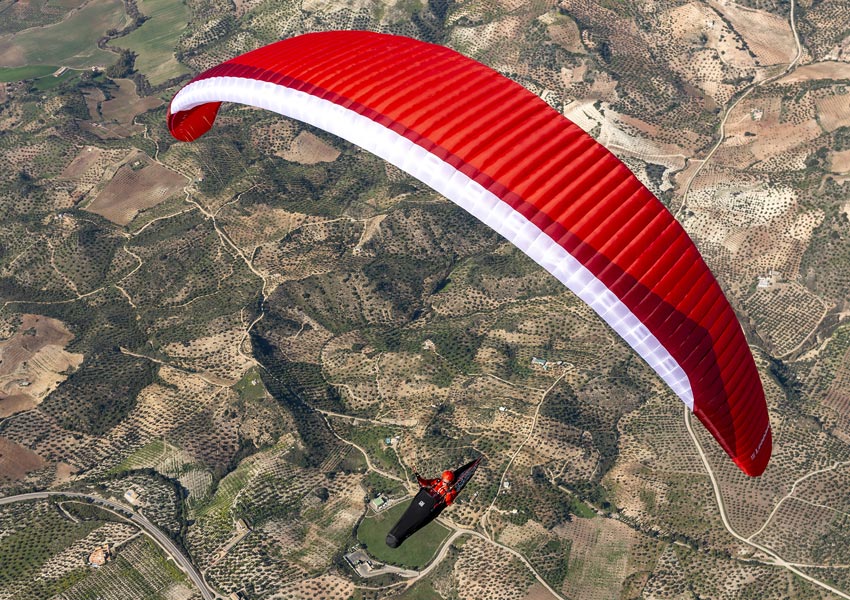
Q&A with Gin designer, Torsten Siegel
What are you most proud of with this wing?
I love the Leopard for the way it feels like a whole wing that really connects you with the elements. It’s cohesive, but not stiff. The most exciting phase of the two-year project was the final tests in Mexico, comparing our final prototype against the competition in extremely rough conditions. Its stability really shone through. We then did the EN tests in Yelapa, towing over the ocean with whales swimming beneath!
The construction looks really complex when looking down on the top surface – tell me more!
Thanks for recognising this – most pilots don’t and this is very frustrating for a designer! Seriously, it’s true that a glider with 86 cells has a very complex structure. The CAD drawing (below) shows the different diagonal and horizontal constructions – it was a big challenge to balance position, shape, tension, cross-ports and so many other related construction features. Besides this, we spent weeks developing the profiles over the whole span. They in turn interact with the sail construction, which complicates the tuning further. But in the end we were convinced we found the right balance.
You didn’t opt for polyamide (PA) rods – why?
The Leopard uses five different rod diameters [from 1.5mm to 2.5mm] and three different materials. It took us a long time to find the right materials, which provide a stable length. Standard PA rods expand by 3% with water, which alters their length; our materials don’t suffer this issue. Different diameters and stiffnesses are selected according to the varying forces and characteristics across the span.
Did you set out to make the Leopard faster than its competitors?
Yes, we compared this a lot. A major part of the Leopard’s brief was to be competitive with all existing two-line EN-D models. A high max. speed is important for competitions – you don’t like to lose when you race to goal. We’re also pleased we achieved a high max. speed with only 14cm of travel on the risers – shorter than some competitors.
What’s the difference between the stated and the CIVL aspect ratio?
There’s no standard protocol for how CAD aspect ratio calculations should be done. There’s a big difference if you add the ballooning or subtract a negative tension, for example, and the data varies a lot between brands depending on how they calculate it. CIVL have a specific measurement that specifies how span, chord and trailing edges are calculated to give a “CIVL” aspect ratio.
This review was published in XC204 (October 2019)
FOOTNOTE: THE LEOPARD IN COMPETITION
(Interview by Hugh Miller)
A few months after we wrote our review, the Leopard has been performing well in South American competitions – notably at PWC Argentina, and the Colombian Nationals. Alex Coltman flew his Leopard M to a top 10 overall finish at the latter, after flying a Zeno for two seasons. Alex is known for his independent, out-front flying style, and I was curious to ask him for his impressions of the wing.
“For the first two days I didn’t like the Leopard at all”, said Alex. “I’m now not certain whether that was down to my winter rustiness, or the wing itself. I’ve heard from a few people that the glider settles after the first few hours of flying, and it feels like that’s right, but it could equally just be me getting used to conditions and the wing. I’ve now flown it for around 25 hours.”
How about the thermalling – do you find it ’sniffier’ than the Zeno?
I do find it easier to recentre in the core than the Zeno. It gives a little more feedback I think, mostly through the brakes but roll seems to give good information too.
I had to keep re-running my speed check – is it as quick as I think?
The pace is really fast out here in Colombia at the British Winter Open – much faster than last week’s Colombian Nationals. On glide, I’m finding my top speed is faster than some Enzo 3s and maybe a little slower than others. But it’s all very close. I’ve had both Enzo pilots and Guru pilots saying they couldn’t keep up with me, and sometimes performance difference is more noticeable to others than yourself.
How about the rear-riser control?
On glide, the Bs are heavier than the Zeno, and seem to have a slightly delayed reaction – but it all works well enough. I’ve had to stop one full-bar frontal and the glider gave plenty of warning that I should do something and reacted nicely to a quick dab. As I said, the glider is fast on full bar for sure but also feels quite nervous….or maybe that’s me! Annoyingly, the B-bars seem too short for all four fingers, so I was getting really tired fingers after tasks. I’ve now taken to holding the actual risers above the handles which means for small inputs I can just twist the riser backwards but I’m ready to heave on the handles if needed, too. The speed bar may be a touch heavier than the Zeno, but it’s not a problem.
Any other comments?
The details and finishing touches are nice. The top gallery lines get tangled quite easily as they’re so thin, but they haven’t actually knotted. I’d like the handles and B-bars to be a bit bigger, and the magnetic poppers are not strong enough.
Overall I would say it’s fast, confidence-inspiring for most of the speed range, and gives enough feedback for hunting the thermals. Maybe it’s a little difficult to get it to turn into very small fast cores – but that’s me comparing it to my small Enzo 2 which was simply the best glider ever made!
Originally released in Cross Country Issue 204 (Oct 2019)


